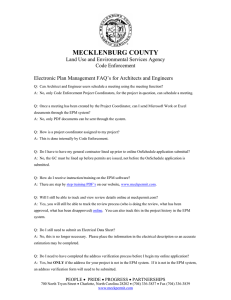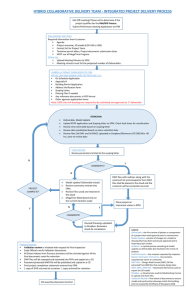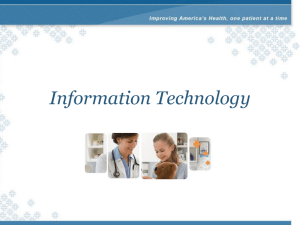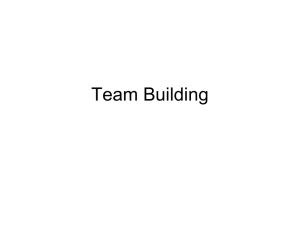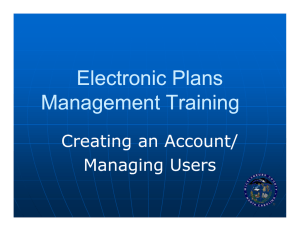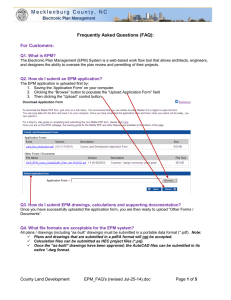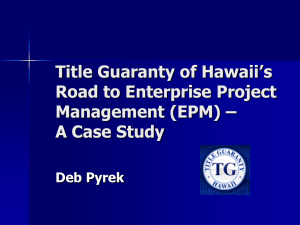Employee Performance Management
advertisement
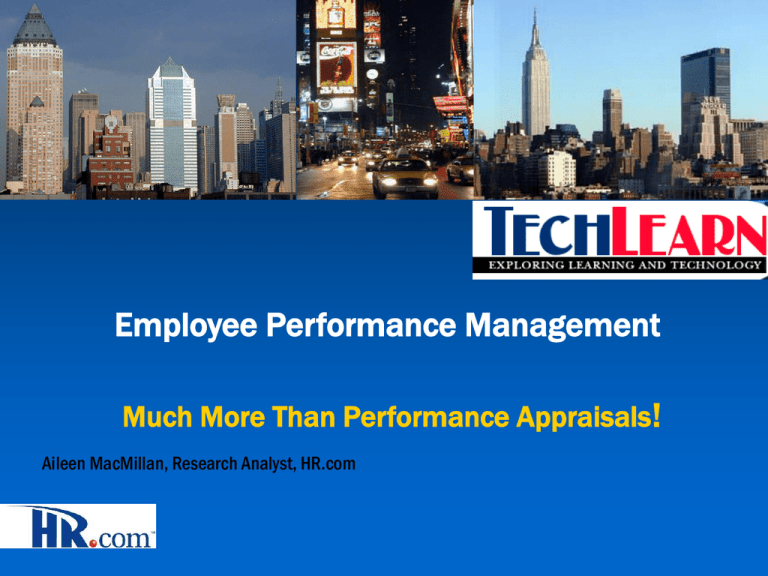
Employee Performance Management Much More Than Performance Appraisals! Aileen MacMillan, Research Analyst, HR.com HR.com Who we are: • Committed to making your life easier! • Connecting you to information, resources, experts, research • 135,000 HR and Training professionals What we provide: • • • • • • • • Articles, online learning seminars Interviews with Thought Leaders Industry research reports Conferences New for 2005 – Executive Councils – communities of peers networking and sharing best practices Join now at www.hr.com Copyright HR.com 2004 Employee Performance Management Overview • A variety of performance management philosophies results in a variety of practices • The role of technology Copyright HR.com 2004 Agenda • Trends • What do we want to achieve? • Performance Management continuum • Marketplace and vendor offerings • Planning to avoid pitfalls • Two case studies • ROI • The future? Copyright HR.com 2004 Current Trends • One of the top five trends for senior HR professionals • Significantly drive employee performance and corporate results • Traditionally, still a very manual process • Increasing interest in pay for performance processes and succession planning Copyright HR.com 2004 Components • Components: • Appraisal and assessment • Support and coaching • Alignment of goals • Development planning • Skill identification • Identification of training needs including certification • Succession planning • Tracking and reporting Copyright HR.com 2004 Benefits • Higher profits • Better cash flow • Stronger stock market performance • Improved productivity Hewitt Associates, 1994 Organizations with culture aligned with business strategy outperform those that are not aligned “The New Corporate Cultures” (Deal and Kennedy) • Higher returns on investment and stock price increase Copyright HR.com 2004 “The most effective performance management systems are characterized by their consistent use throughout the organization, their integration with other systems, senior management involvement, employee involvement, and their links to organizational strategy” DDI “Managing Performance: Building Accountability for Organizational Success, Executive Summary” Copyright HR.com 2004 Employee Performance Management Maturity Model 4. Orchestrating 3. Anticipating 2. Coping • Enterprise-wide alignment with financial and operational processes • Driven from the top • Clear alignment and visibility • Focus on performance and behaviors • Driven by HR, lives in LOB • Cross-functional metrics • Consistent tools and methodology • Project managed by HR This is where most large organizations are today. 1. Reacting • Departmental metrics • Paper or Word/Excel files • Manual and/or e-mail Source: AMR Research, 2003 Copyright HR.com 2004 Moving From Paper to Technology • Increased effectiveness • Ability to measure results • Maintain and track accountability • Ensure appraisals are related to day to day activities • Link to organizational objectives • Ensure consistency • Identify training • Accurately link performance ratings to compensation Copyright HR.com 2004 Overview of the EPM Marketplace • Larger players, including ERP and HRIS vendors • Niche or Best of Breed players • Single solution • Suite of integrated modules • Build your own solutions Copyright HR.com 2004 Overview of the EPM Marketplace Copyright HR.com 2004 Capabilities • Cascading and linked goals • Competencies • Central dashboard • Configurable workflow • Appraisal preparation support • Manager support/coaching tips • Extensive reporting options • 360° feedback or multi rater feedback • Links to other modules or full integration Copyright HR.com 2004 What Do We Want to Achieve? Copyright HR.com 2004 Avoiding Pitfalls • Ensure support from the top of the organization • Develop a strategic plan • Develop a forecasted budget • Update job descriptions • Transparency and trust • Identify actionable items for each goal • Link individual goals with organizational goals • Build in accountability • Provide appropriate training • Determine if tied to compensation management Copyright HR.com 2004 Change Management Copyright HR.com 2004 Case Study – City Public Service • City Public Service (CPS), the nation’s largest municipally- owned energy company, located in San Antonio, TX • Just over 4,000 employees • Strong commitment to encouraging employee performance • Purchase of an EPM software solution seen as a key initiative to support the performance management process Copyright HR.com 2004 Guiding Principles • To move from a paper-based to a paperless system • Decrease administrative time • Allow tracking and alignment of goals • Ensure quality evaluations • Increase feedback related to competencies • Provide effective performance management data • To move from an anniversary date appraisal completion process to a common completion date Copyright HR.com 2004 Steps Taken • Only 45 days from purchase to the “go live” date • A variety of levels of computer literacy amongst employees Steps taken: • Began with sound performance management processes in place • Customization of solution to fit specifications • Formation of an implementation team • Development of a detailed implementation plan • Utilization of train the trainer program • Designation of software support representatives • Clarification of roles and responsibilities Copyright HR.com 2004 Results • Completion of 1,983 salaried employees annual appraisals in a period of 60 days • Annual merit increases awarded approximately one month later • Eliminated work load of approximately four different personnel allowing them to focus on other HR functions • Improved on time completion rates • Increased consistency of process • Reduction in need for storage space • Substantial reduction in future administrative time Copyright HR.com 2004 Case Study – Sears, Roebuck and Co. • Employs about 220,000 Associates, in over 3000 locations • Performance Management is a daily process • Formal reviews are conducted for all Associates once a year • Performance review process is tied to the calculation of merit and incentive payments • Review process tied to Talent Management Process • Custom developed web tool Copyright HR.com 2004 Guiding Principles • Fundamental belief rewards are tied to performance • Streamlined way to manage process • Consistent communication to Associates • Reporting and management of performance initiatives • Accurate calculation of pay Copyright HR.com 2004 Steps Taken • Strong performance management process and communication system in place • Identification of personal goals, performance goals and competencies • System to identify accountabilities and responsibilities by process • R = Responsible • A = Accountable • C = Consulted • I = Informed • Safeguards to ensure fairness and consistency of pay for performance • Gradual implementation of change Copyright HR.com 2004 Results • Identification and refinement of key performance measures • Greater understanding of employee skill level • Increased accountability and personal responsibility • Increased clarity around performance scores • Improved consistency amongst performance expectations • Fairness of pay for performance Copyright HR.com 2004 Common Elements Support from the top of the organization Develop a strategic plan Build in accountability Link individual goals with organizational goals Provide appropriate training Update job descriptions Determine if tied to compensation management **Ongoing communication, value and trust** Copyright HR.com 2004 Tips From Current Users • Ensure sound performance management practices are in place, a software solution will not replace proper supervision • Roll out the process step by step • Thoroughly research before making a buying decision • Go in with your eyes open – have clear expectations and ask questions up front • Consider your future needs • Make sure your infrastructure will support the software • Get to know your vendor Copyright HR.com 2004 Return on Investment • Increased efficiency • Ability to identify and keep top performers • Significantly reduced grievances • Increased clarity and accountability • Consistency of process • More formalized process • Improved quality of reviews • Increased alignment • Employee satisfaction Copyright HR.com 2004 Future of EPM Software • Trend towards consolidation • “EPM software market will demonstrate at least a 15% compound annual growth rate through 2008” Gartner, 2004 EPM MarketScope Copyright HR.com 2004 Aileen MacMillan HR.com amacmillan@hr.com End of Presentation
